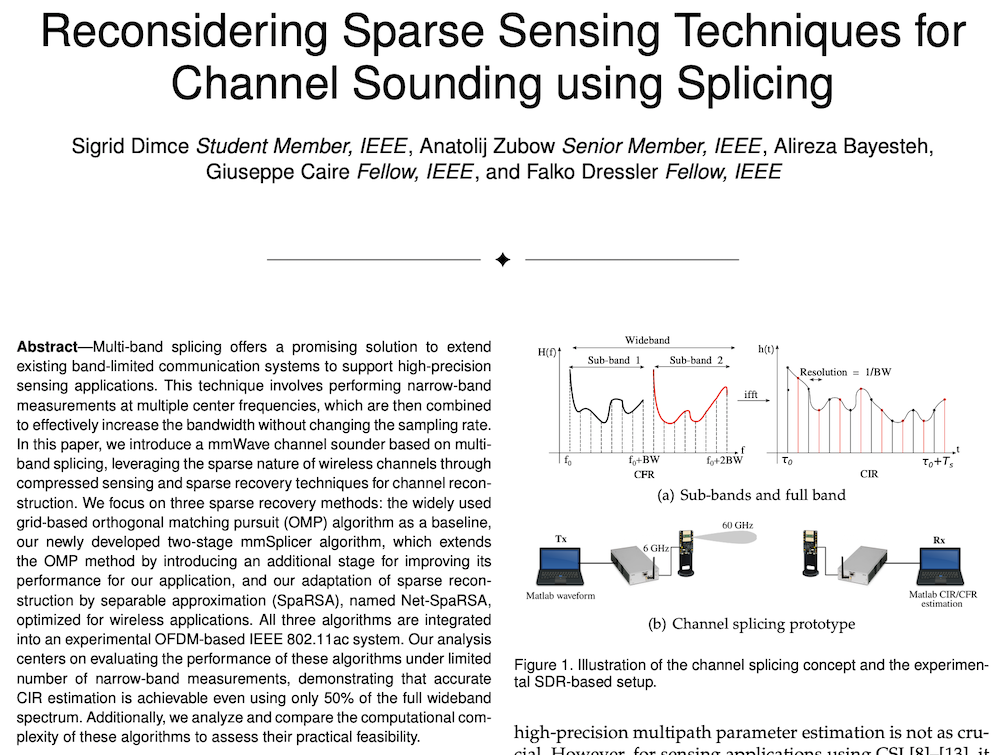Literature Database Entry
amjad2020inband
Muhammad Sohaib Amjad, Max Schettler, Sigrid Dimce and Falko Dressler, "Inband Full-Duplex Relaying for RADCOM-based Cooperative Driving," Proceedings of 12th IEEE Vehicular Networking Conference (VNC 2020), Virtual Conference, December 2020.
Abstract
We explore the use of RADar based COMmunication (RADCOM) as a complementary communication tech- nology for next-generation Intelligent Transportation Systems (ITS). RADCOM makes use of vehicular radar operating in the 77 GHz mmWave band. Using platooning of cars on the freeway as an example application, which could benefit substantially from mmWave high bandwidth transmissions with low latencies along the platoon, we propose to combine Full-Duplex Relaying (FDR) with RADCOM. Full-duplex relaying at the 77GHz band benefits from the directionality of the signal, which leads to reduced Looped Self-Interference (LSI). We developed a real-time simulation model based on GNURadio to study the mmWave propagation in platoons. In particular, we investigate the opportunities of inband FDR for RADCOM. Our first results clearly indicate the advantages of the proposed approach in terms of reduced physical layer latency and energy requirements while maintaining optimal channel link rates.
Quick access
Original Version ![]() (at publishers web site)
(at publishers web site)
Authors' Version ![]() (PDF on this web site)
(PDF on this web site)
BibTeX ![]()
Contact
Muhammad Sohaib Amjad
Max Schettler
Sigrid Dimce
Falko Dressler
BibTeX reference
@inproceedings{amjad2020inband,
author = {Amjad, Muhammad Sohaib and Schettler, Max and Dimce, Sigrid and Dressler, Falko},
doi = {10.1109/VNC51378.2020.9318397},
title = {{Inband Full-Duplex Relaying for RADCOM-based Cooperative Driving}},
publisher = {IEEE},
issn = {2157-9865},
isbn = {978-1-7281-9221-5},
address = {Virtual Conference},
booktitle = {12th IEEE Vehicular Networking Conference (VNC 2020)},
month = {12},
year = {2020},
}
Copyright notice
Links to final or draft versions of papers are presented here to ensure timely dissemination of scholarly and technical work. Copyright and all rights therein are retained by authors or by other copyright holders. All persons copying this information are expected to adhere to the terms and constraints invoked by each author's copyright. In most cases, these works may not be reposted or distributed for commercial purposes without the explicit permission of the copyright holder.
The following applies to all papers listed above that have IEEE copyrights: Personal use of this material is permitted. However, permission to reprint/republish this material for advertising or promotional purposes or for creating new collective works for resale or redistribution to servers or lists, or to reuse any copyrighted component of this work in other works must be obtained from the IEEE.
The following applies to all papers listed above that are in submission to IEEE conference/workshop proceedings or journals: This work has been submitted to the IEEE for possible publication. Copyright may be transferred without notice, after which this version may no longer be accessible.
The following applies to all papers listed above that have ACM copyrights: ACM COPYRIGHT NOTICE. Permission to make digital or hard copies of part or all of this work for personal or classroom use is granted without fee provided that copies are not made or distributed for profit or commercial advantage and that copies bear this notice and the full citation on the first page. Copyrights for components of this work owned by others than ACM must be honored. Abstracting with credit is permitted. To copy otherwise, to republish, to post on servers, or to redistribute to lists, requires prior specific permission and/or a fee. Request permissions from Publications Dept., ACM, Inc., fax +1 (212) 869-0481, or permissions@acm.org.
The following applies to all SpringerLink papers listed above that have Springer Science+Business Media copyrights: The original publication is available at www.springerlink.com.
This page was automatically generated using BibDB and bib2web.





